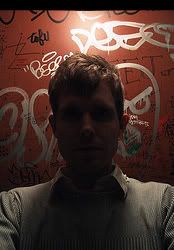The WItch of the Waste
The tugboat is just trapped there, in the last leg of the canal, as if the city grew up around it before it could escape. I have to get off my bike and stop for several minutes to think about this, even though the rain will be here any minute. I don't want to be caught out in it so far from anything-- there are no restaurants here, no stores, not even any homes. Ride ten blocks east from anywhere along Graham Avenue and you will find yourself right on the edge of New York City's flat earth, prey to the sea monsters and nightmares that romp below.
This tugboat is one of them. There is a bridge blocking it off from the main artery of the canal, and it sits low in water so colloidal and grey that you can't tell where it meets the shore in some places. You would have to survey the spot where the carpet of debris suddenly rises a foot and then scan for rocks and mortar poking through. If I fell in I'd rather sink like a stone and die than have to claw my way ashore and find a way to rinse off.
I can't ride out any further than Onderdonk Avenue before the rain intensifies and adds to the chorus of subliminal voices telling me that humans do not belong here. Places that would have to be fenced off in my neighborhood to keep people out are left wide open out here; I doubt many are so desperate as to trespass in a place where the earth itself is crusted with glass and rainbow-hued ooze. Homelessness that leads one to end up sleeping on Park Avenue is a sort of deity-in-disguise artfulness; homelessness that leads one to this place is a howl of true mind-death.
I love these places; I can afford to love them, because I have had no part in their creation or proliferation. This is an alien landscape to me, coming as I have from a newer city in the desert with unique environmental demands. You can find a wasteland in almost any city, but New York gets away with the worst of everything because of all the dazzling amusements nearby drawing the eye away from the worst of it. What it can't hide, the city pretends to embrace, having added excess, unfriendliness, strange odors, and crime to its list of features that city-dwellers have grown to love. Love us, and love our cesspools too! crows the city, and you are more than happy to-- except when most people imagine the worst the city has to offer, they are visualizing its ghettos. Its wastelands are unknown to all but the most dedicated laborers and determined curiosity-seekers.
Here is a five way intersection with more wide-open sky overhead than I've seen since I was home for Christmas. The buildings out here are monumental and functional, the great molars that grind up whatever has yet to be broken down before it lands in a heap just beyond. Even I can't tell for sure why it feels so obscene to linger here, why it's too much to bear unless you are whizzing past in a car like people must if they want to take this route between Brooklyn and Queens. Perhaps it's only because of the radiance of the city itself. Standing here and dwelling on it is like poring over photos of celebrity autopsies-- the beauty was never meant to be seen this way, from the inside out.
I think that I would like to live just nearby, between Olive Street and Morgan Avenue, in that borderland where you know something awful must be nearby because the road widens and the street slopes ever more downhill below you. A quiet place to live, with few children and rare foot traffic, and the lonely blasts from eighteen-wheelers reminding me of home and of every road trip I have ever taken. To live within equal walking-distance of the L train's Graham stop and a diesel-only filling station that I've never seen open for business. To have access to haunting vistas of billboards that advertise movies from five years ago, aging worse-- if it's possible-- than the films themselves have. To have the world divided so cleanly that, upon leaving the house, you will always know immediately whether you are walking the right way or the wrong way. And to walk the wrong way when it suits you, to wind up searching for a clean place on the stones by the Mary H. as she pines for other boats to tug along, festooned with old tires and seeming herself to be the most inhabitable object one could ever hope for, the last outpost of beauty you are liable to find on your way to where the earth can't bear to go on, the end of the East.









